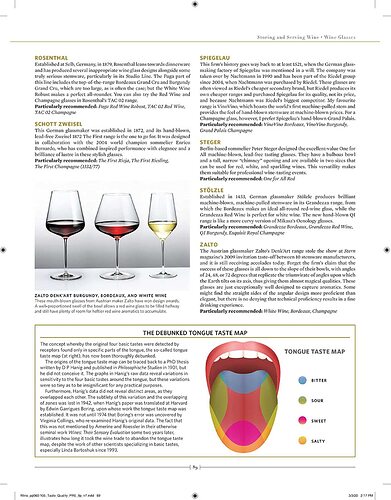Book Review:
The Sotheby’s Wine Encyclopedia
(5th Edition, 2011)
736 pages
Tom Stevenson
Because of my wont of buying old wine books on Amazon this popped up on my feed and I had a copy dispatched ($8.73 shipped) and read it cover to cover over six months, a couple pages every few nights. This prolific author is new to me but this book is excellent, and I plan to buy the next/newest editions. It’s genuinely a useful reference book, especially for areas that Stevenson cares deeply about.

It’s arranged differently than most wine books, and has a strongly opinionated editorial tone. It does NOT feel like a book that has been assembled with input from many local experts, with differing views, and when the author shares others views, they seem to get attributed well.
The first ~ 70 pages cover factors that affect Taste & Quality, and include Location, Climate, Soil, Viticulture, Training, Vines, Harvesting, Vinification, types of winemaking, Oak/Barrels, Varietals, Glassware, Taste, Proper Assessment, Aromas, and Faults. Relative to other wine books, this section is less formulaic, and more editorial. Even if one is a long time enthusiast, I’d be surprised if someone did not learn something new, but there could also be points where someone might go ‘hmmm’. He covers influences like the Humboldt Current that I have not seen touched on in other tomes, and has drawings of major types of vine training, along with practitioner views on the advantages of such. For topics like Oak, there are close up pictures of the various grain differences, with explanations of how those might affect the end product. The first part is great reading, even for professionals.
The next short section presents a select Chronology of Wine as well as some numbers of what production is in each area. Most WB’s generally forget how much wine is made, and at what low prices it fetches, since oenophiles are focusing on a sliver of top wines.
Then it breaks into regional sections. France comes first at 200 pages, which generally takes the format of national introductions where AOC, DO, DOCG, AVA etc. types of rules are covered as well as important quirks consumers/collectors ought to know. Then it dives into local areas, with select producer profiles. His selections of key estated to focus on is different than what a US consumer oriented writer might have picked a decade or so ago. To me, that’s ok – I like getting a different point of view, and there are strong, substantiated opinions offered up here.
Italy comes next and gets 50 pages. When the regions are discussed, the author is exhaustive, and obscure/strange/non relevant/non imported DO’s clutter up a lot of the sections. So expect to see some areas that may not be germane, with curt observations that the wines should be purchased locally, and drunk immediately with low expectations. So there are parts of the book that can be skimmed through, or just called upon in rare situations when one has to figure out what a gift or bequest is. In general the maps are excellent, but producer labels (which are mostly filler) are fairly few. Spain gets ~ 30 pages, which feels light to me, but at least what’s there is Rioja centric. Sherry receives more attention than I’ve seen in typical wine books, and if one cares about that niche, they can’t complain. Portugal is allocated 15 pages, which is mostly on Port. The German wines get a whopping 50 pages, and some of the more famous vineyards (Bernkasteler Doktor etc.) are covered in depth, surprising for such a global tome. Britain and other regions then get 20 pages, with a tremendous amount of detail on UK sparkling wine producers. This is one of those areas where it becomes quite obvious where the authors personal passions lay.
Less collectible areas consume the next 50-75 pages, depending on what one might consider as interesting. The sections are generally well written, interesting but are included for comprehensiveness rather than utility to Anglo consumers. (How many care about Romanian or North African wines? but the product is pitched as an Encyclopedia to be fair)
North America is next, and soaks up the next 90 pages, with a rightful focus on the West Coast. Interestingly the author has taken the trouble to visit some of the mega producers facilities/factories (Bogle, Mondavi/Woodbridge) as well as the non glamour inland areas (Amador, Fairplay etc.) that do not normally get covered in fine wine writing. Stevenson is thorough, even if one might not agree with all his confusing ratings, or editorial interjections on clonal selection. After that are 70 pages on OZ, NZ and other Asia. The coverage is extensive for this area, relative to what I see on the shelves of stores. Most names I’ve seen locally have some commentary, which was helpful, but driven by the quirk that China is not importing these wines now, and that surplus have made their way here, at low prices. Below is an example of the kind of illustrations that are included throughout the entire book; this might be a newer edition though.
Although the Atlas is from 2011, and parts were clearly composed years before that, it is still germane. The newest edition is the 6th from 2020, with editing work now credited to another writer as well; publishing switched from DK to National Geographic. I see that secondhand paperback copies remain available for a song. The book is large, awkward and difficult to manage in a chair. It’s a minor point, but that makes it hard to chew through as a ‘book’ rather than as a reference tome only pulled from a shelf when some obscura needs to be clarified. If one wants a 5th edition, they’re $6-$8 shipped on Amazon and purchasers will get their money’s worth as it takes months to read.
Overall: I recommend enthusiastically.
